Mon - Fr 9:00 am - 5:30 pm
3760 Oceanic Way STE 501, Oceanside, CA 92056
Posted by Gen819 Comments Off on Attic Insulation Upgrades That Cut Cooling Costs Roofing Materials
Attic Insulation Upgrades That Cut Cooling Costs
It’s a sunny afternoon in San Diego — not unusual for this part of the world. The air conditioner hums steadily as the family tries to keep cool, yet the house never seems to reach that perfect, comfortable temperature. The electric bill keeps climbing each month, and most homeowners assume their aging AC system is to blame. But in many cases, the real problem isn’t the air conditioner at all — it’s what’s happening above the ceiling.
Hidden just out of sight, the attic often acts like a giant heat trap. Without proper insulation, that heat radiates downward into living spaces, forcing your cooling system to work overtime. In fact, inadequate attic insulation is one of the most common — and most overlooked — sources of energy loss in San Diego County homes.
In this article, we’ll explore how attic insulation affects your home’s comfort and efficiency, why many local homes are under-insulated, and how an upgrade can dramatically lower your energy bills while making your home more comfortable year-round.
1. Why Attic Insulation Matters in San Diego’s Climate
Because San Diego enjoys mild winters, many homeowners assume insulation isn’t that important here. After all, snow and freezing temperatures aren’t part of life in Southern California. But what’s often overlooked is that insulation doesn’t just keep heat in—it also keeps heat out. And with more than 260 sunny days a year, managing heat gain is one of the biggest challenges for local homes.
During the long warm season, the sun beats directly on your roof, driving attic temperatures to well over 120°F, even near the coast. Without enough insulation, that trapped heat radiates down into your living spaces, making your air conditioner run constantly to keep up. The result? Higher cooling costs, uneven indoor temperatures, and rooms that never seem to stay comfortable.
Proper attic insulation acts like a protective thermal barrier between your living area and the scorching air above. It helps maintain consistent indoor temperatures, reduces stress on your HVAC system, and makes your home quieter and more comfortable. Whether you live along the breezy coast of Oceanside or farther inland in Escondido or El Cajon, insulation is a key factor in keeping your San Diego home energy-efficient and comfortable year-round.
 2. The “Hidden Energy Leak”: How Poor Insulation Wastes Energy
2. The “Hidden Energy Leak”: How Poor Insulation Wastes Energy
Every home is in a constant battle with heat. In summer, the sun’s rays pound your roof, heating the attic air until it becomes a miniature furnace. Without sufficient insulation, that heat easily transfers through the ceiling and into your living space. Your air conditioner responds by running longer and harder — yet much of its effort literally goes through the roof.
This process happens through three forms of heat transfer:
- Conduction: Heat travels through solid materials, like the ceiling drywall and roof decking.
- Convection: Hot air circulates within the attic, warming cooler areas below.
- Radiation: Infrared heat energy from the roof radiates downward into your home.
Together, these mechanisms create a hidden “energy leak” that can waste up to 25–30% of your home’s heating and cooling energy. Even small gaps in insulation coverage can lead to big losses.
The result is a home that’s harder to cool, rooms that never feel quite right, and monthly utility bills that climb higher than they should. Over time, your HVAC system wears out faster from overuse, costing you even more in repairs and replacements.
Proper attic insulation plugs this invisible energy drain — creating a home that stays cooler, more efficient, and more comfortable with far less effort.
3. Why So Many San Diego Homes Have Insulation Problems
If you live in San Diego County, chances are your home’s attic insulation isn’t performing as well as it should — or worse, it’s barely there at all. Many local houses, especially those built before the 1990s, were constructed when energy efficiency simply wasn’t a major concern. Builders focused on structure and appearance, not on sealing and insulating the attic space above. As a result, countless older homes in Oceanside, Carlsbad, Vista, and beyond still have just a few inches of outdated fiberglass insulation — far below today’s energy standards.
Over time, insulation settles, compresses, and loses its effectiveness. Dust, humidity, and even minor roof leaks can degrade materials, reducing their ability to block heat transfer. In coastal neighborhoods, salt air and moisture can accelerate that deterioration, while inland homes endure more intense roof heat that bakes insulation from above.
Even newer homes aren’t immune. Construction timelines are often tight, and insulation can be poorly installed or unevenly distributed — leaving gaps that allow heat to flow freely. Add to that years of neglected attic maintenance, HVAC retrofits, or pest disturbances, and it’s easy to see how energy loss becomes a hidden, ongoing issue.
The good news? Modern insulation materials and installation techniques can restore — and often exceed — your home’s original energy efficiency, helping you reclaim comfort and lower your energy bills year-round.
4. Signs You May Need an Attic Insulation Upgrade
Because attic insulation is out of sight, it’s easy to forget about — until comfort or energy costs become a problem. Fortunately, there are several telltale signs that your home’s insulation is underperforming. If you recognize any of these issues, it may be time to schedule an attic inspection.
1. Uneven Temperatures Throughout the House
Do some rooms feel much hotter in summer or colder in winter? Inadequate insulation allows heat to flow freely, creating hot and cold spots, especially in upstairs or west-facing rooms.
2. High Summer Energy Bills
If your air conditioner seems to run constantly but your home still doesn’t stay cool, your attic may be letting in more heat than you realize. Better insulation helps reduce that load, allowing your HVAC system to work efficiently.
3. Hot Ceilings or Walls
Try touching the ceiling on a sunny afternoon. If it feels warm to the touch, heat is radiating directly from the attic into your living space — a clear sign of poor insulation or a missing radiant barrier.
4. Dusty Home or Poor Air Quality
Air leaks in the attic can draw in dust, allergens, and outdoor air. Proper insulation and air sealing help create a cleaner, more comfortable indoor environment.
5. Older Home (Pre-1990 Construction)
Many homes built before modern energy codes were adopted simply don’t have enough insulation to meet today’s standards.
6. Pest or Moisture Problems
Rodents, birds, or roof leaks can disturb or damage insulation, reducing its effectiveness and even creating health hazards.
If one or more of these signs sound familiar, your attic is likely due for an upgrade — a small improvement that can deliver a big payoff in comfort, air quality, and monthly savings.
5. The Science of R-Values: How Much Insulation Does a San Diego Home Need?
When it comes to insulation, R-value is the key measure of performance. The “R” stands for resistance — specifically, resistance to heat flow. The higher the R-value, the better the material is at slowing the transfer of heat. Every inch of insulation adds more resistance, helping your home stay cooler in summer and warmer in winter.
In San Diego’s coastal and inland climate zones, the California Energy Code (Title 24) recommends attic insulation with an R-value between R-30 and R-60, depending on your home’s construction and location. Unfortunately, many older homes in the area only have R-13 to R-19 — barely a fraction of what’s needed for optimal performance.
That difference adds up. A properly insulated attic can reduce energy loss by up to 40%, significantly lowering your air conditioning costs during San Diego’s long warm season. For homeowners already using solar power, better insulation also means more of that solar energy goes toward powering your lifestyle — not making up for wasted cooling effort.
Upgrading your insulation to meet modern R-value standards isn’t just about following code — it’s about maximizing comfort, efficiency, and long-term savings in a region where the sun shines nearly year-round.
6. The Best Insulation Options for San Diego Homes
Not all insulation materials are created equal — and in Southern California’s warm, sunny climate, some work much better than others. Choosing the right type depends on your home’s age, attic layout, and energy goals. Here’s a look at the most effective insulation options for San Diego homeowners:
1. Blown-In Cellulose Insulation
Made from recycled paper treated for fire and pest resistance, blown-in cellulose is an eco-friendly and cost-effective option for existing homes. It fills small gaps and hard-to-reach corners, providing even coverage over older fiberglass batts. It’s especially useful for retrofits where removing old insulation isn’t practical.
2. Fiberglass Batt Insulation
This is the classic pink or yellow material most homeowners recognize. Fiberglass batts are affordable and easy to install in open attics or during new roof construction. However, they can leave gaps around joists and obstructions if not installed perfectly, reducing their effectiveness.
3. Spray Foam Insulation
Spray polyurethane foam expands on contact to seal cracks, gaps, and air leaks while providing an excellent R-value per inch. It’s ideal for homeowners who want maximum energy efficiency and air sealing in one step. Spray foam can also help control humidity — a bonus for homes near the coast.
4. Radiant Barriers
Radiant barriers are reflective materials installed under the roof deck that bounce radiant heat away before it enters the attic. In sunny regions like San Diego County, this can lower attic temperatures by up to 30°F. Radiant barriers work best when combined with standard insulation materials, forming a powerful defense against heat gain.
5. Hybrid Systems
For the best results, many homes benefit from combining insulation types — for example, pairing a radiant barrier with blown-in cellulose or spray foam. This layered approach tackles both conductive and radiant heat, ensuring optimal comfort and performance year-round.
Whether you live in a beach bungalow or a sprawling inland home, upgrading your attic insulation with the right materials can dramatically reduce cooling costs and make your living spaces far more comfortable.
7. How Insulation, Roofing, and Solar Work Together
When it comes to home energy efficiency, insulation doesn’t work in isolation — it’s part of a complete system that includes your roof and solar power setup. Think of these three elements as a team: when they work together, your home becomes cooler, more efficient, and far less expensive to operate.
Roofing and Insulation: The First Line of Defense
Your roof and attic insulation form the barrier between your home and San Diego’s relentless sunshine. A properly insulated attic keeps the heat from radiating into your living spaces, while a high-quality roof — especially one designed with reflective “cool roof” materials — minimizes how much solar energy is absorbed in the first place. Together, they drastically reduce the workload on your air conditioning system.
Solar Power and Energy Optimization
For homeowners with solar panels, good insulation means your solar energy goes further. Instead of offsetting wasted cooling power, your panels can cover a larger share of your home’s actual energy needs. Plus, a cooler attic can slightly improve the efficiency and lifespan of rooftop solar panels by reducing overall roof surface temperatures.
The Gen819 Advantage
As a licensed roofing and solar contractor, Gen819 Roofing & Solar is uniquely equipped to help homeowners integrate all three systems — roofing, insulation, and solar — into one cohesive, energy-saving solution. By addressing your roof structure, attic efficiency, and solar production together, you can achieve maximum comfort and long-term savings while reducing your environmental footprint.
8. Cost, ROI, and Incentives
For many homeowners, the first question about insulation upgrades is simple: How much does it cost, and is it worth it? The good news is that attic insulation improvements are among the most affordable and high-impact energy upgrades you can make — especially in a sunny, warm region like San Diego County.
Typical Costs and Energy Savings
While every home is different, most attic insulation upgrades in the area range from $1.50 to $4.00 per square foot, depending on the material, attic accessibility, and whether old insulation needs to be removed. Though the upfront cost varies, the long-term payoff is impressive. Homeowners often see 10–30% reductions in energy bills, and the investment can typically pay for itself within three to five years through energy savings alone.
Added Benefits Beyond Energy Savings
Better insulation doesn’t just lower bills — it enhances comfort, reduces noise from outside, and lightens the load on your HVAC system, helping it last longer. Some homeowners also notice improved indoor air quality once air leaks and dust infiltration are minimized.
Tax Credits and Rebates
California continues to offer generous energy-efficiency incentives for homeowners. Through the Inflation Reduction Act, federal tax credits can cover up to 30% of the cost of qualifying insulation and air sealing improvements. Locally, SDG&E and other programs may provide rebates for energy-saving upgrades that meet state standards under Title 24.
When combined with the long-term energy savings and comfort improvements, upgrading attic insulation is one of the smartest home investments you can make.
 9. When and How to Upgrade Your Insulation
9. When and How to Upgrade Your Insulation
If you’ve noticed uneven temperatures, rising energy bills, or any of the warning signs mentioned earlier, it’s time to take a closer look at your attic. Even a quick inspection can reveal whether your insulation is thin, damaged, or outdated — and addressing it sooner rather than later can save you hundreds of dollars each year in wasted energy.
Step 1: Schedule a Professional Attic Inspection
A trained technician can evaluate your attic’s current insulation level, check for air leaks, and measure whether your home meets California’s recommended R-values. They’ll also look for gaps, moisture issues, or compressed insulation that might not be visible from a quick visual check.
Step 2: Pair It with a Roof or Solar Evaluation
If you’re planning a new roof installation or solar upgrade, it’s the perfect time to address insulation. Access to the attic is easier during roofing projects, and combining upgrades helps ensure that every layer — from the roof deck to the ceiling — works together for maximum energy efficiency.
Step 3: Choose the Right Contractor
Proper installation matters as much as the material itself. Working with a licensed, experienced contractor like Gen819 Roofing & Solar ensures your insulation is installed correctly, meets Title 24 standards, and complements your roof and solar systems.
Upgrading your attic insulation may seem like a small step, but it can have a major impact on your home’s comfort, energy use, and long-term value — especially when it’s part of a complete energy efficiency plan.
10. Get Professional Help For Your Attic Insulation
In sunny San Diego County, where cooling costs can rise as quickly as summer temperatures, attic insulation is one of the most powerful — and affordable — ways to improve your home’s energy efficiency. While it’s easy to overlook what’s happening above the ceiling, poor insulation quietly drains comfort and money from countless local homes every year.
Upgrading your attic insulation transforms how your home handles heat. It helps your air conditioner work less, keeps indoor temperatures stable, and ensures that every kilowatt of solar energy you generate truly goes toward powering your lifestyle — not escaping through the roof. Whether your home is decades old or newly built, insulation is a simple upgrade that delivers lasting results.
At Gen819 Roofing & Solar, we specialize in creating complete, energy-efficient homes — combining expert roofing, insulation, and solar solutions designed for the San Diego climate. If you’re ready to uncover the hidden energy leaks in your home and enjoy a cooler, more efficient future, schedule a free attic or roofing consultation today.
Recent Posts
Attic Insulation Upgrades That Cut Cooling Costs
San Diego Roof Lifespans Explained
Do you have any questions?
Contact us at the Gen819 office nearest to you or submit a business inquiry online
Contact Us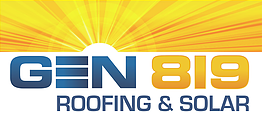
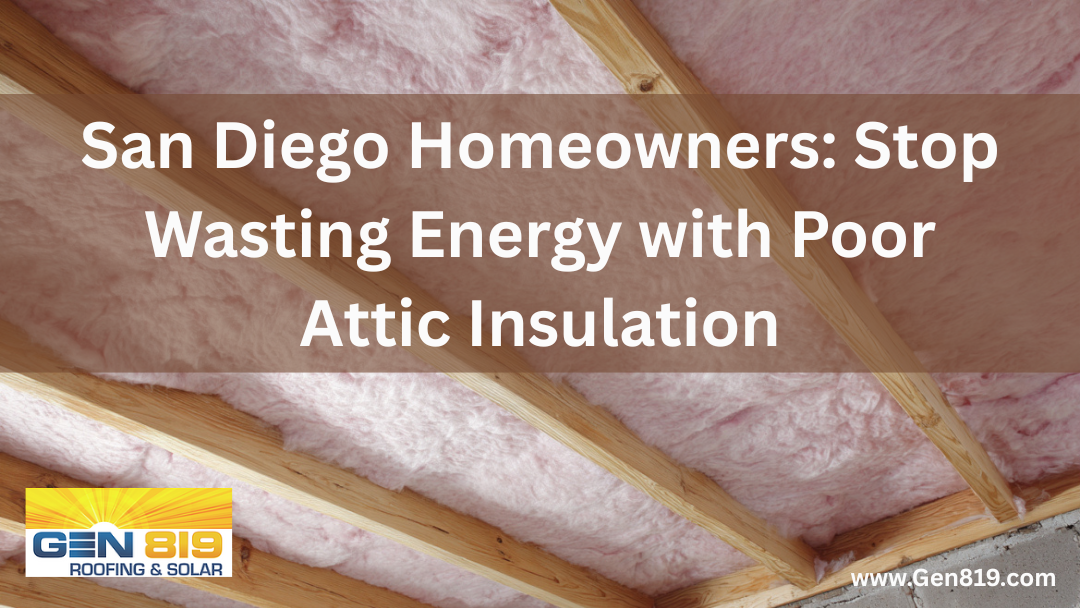
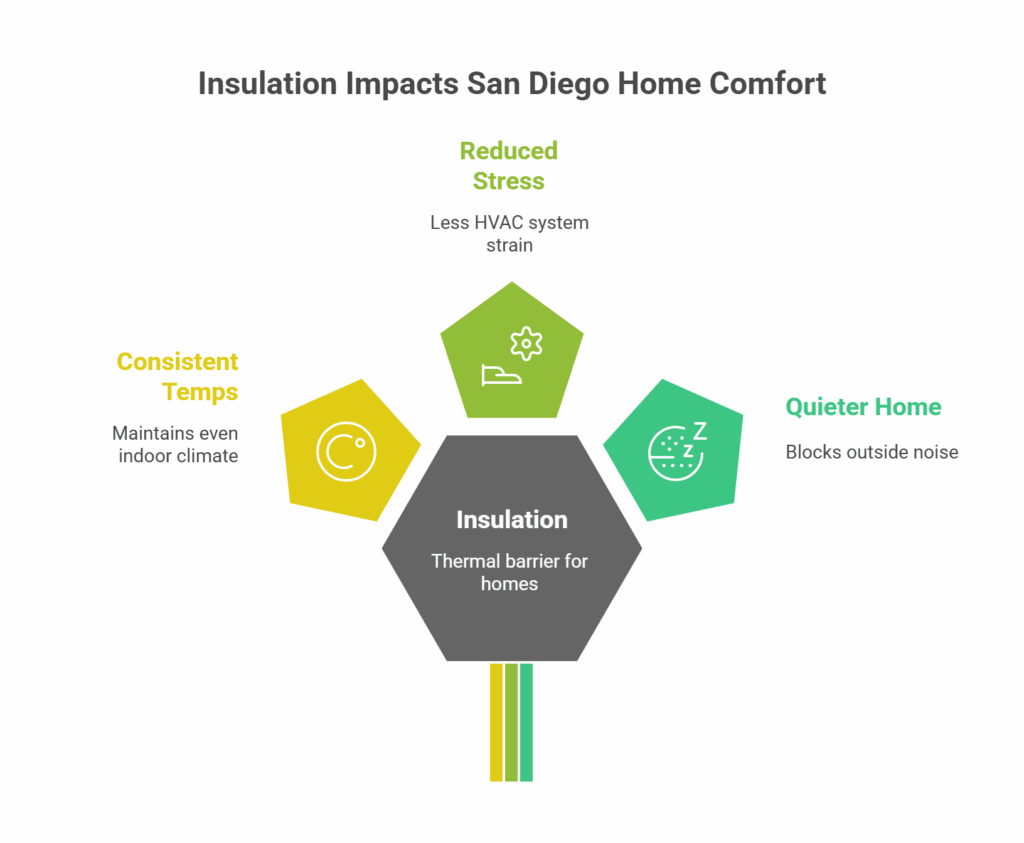 2. The “Hidden Energy Leak”: How Poor Insulation Wastes Energy
2. The “Hidden Energy Leak”: How Poor Insulation Wastes Energy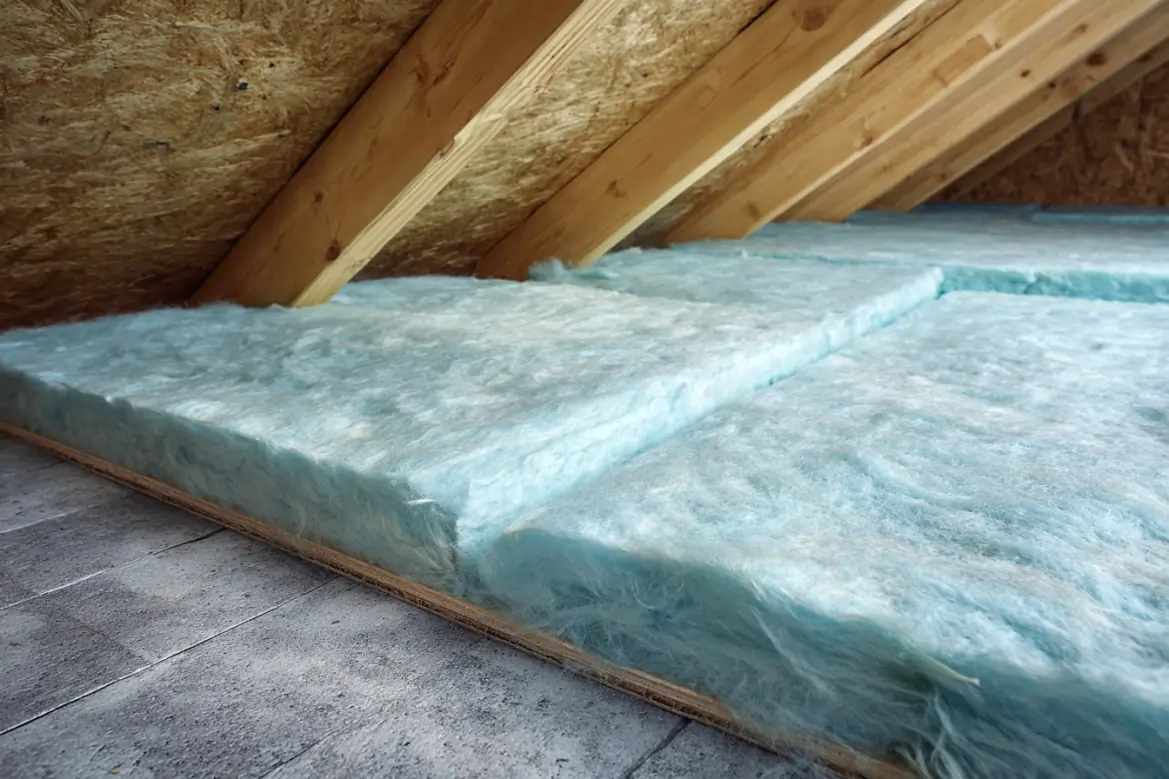

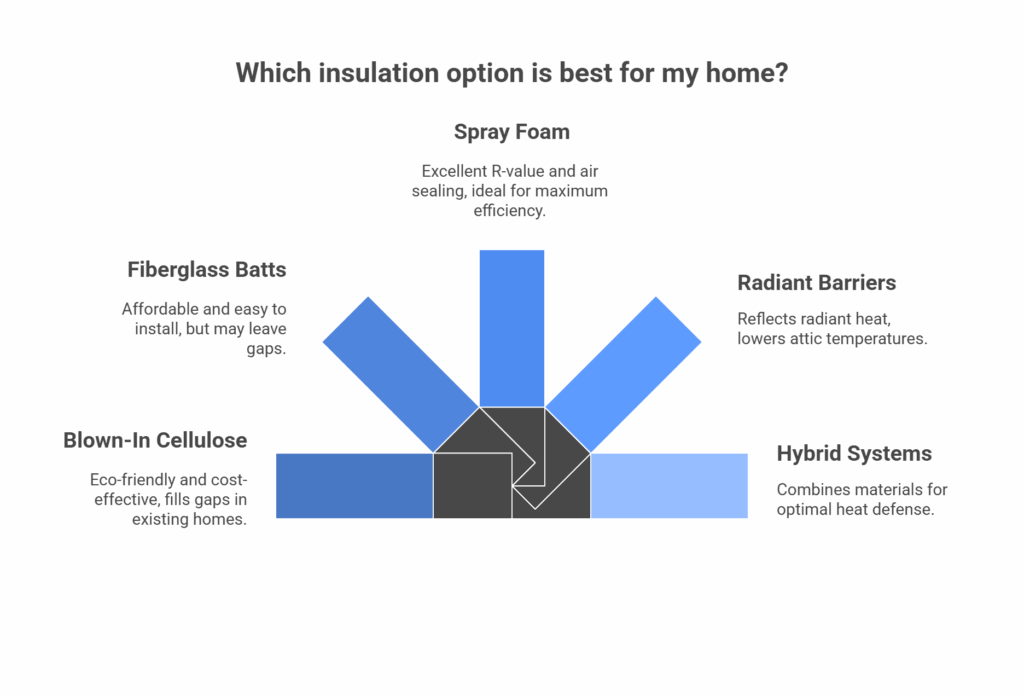
 9. When and How to Upgrade Your Insulation
9. When and How to Upgrade Your Insulation







